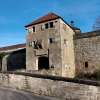Hohenasperg is a historic fortress located atop the Hohenasperg hill in Baden-Württemberg, Germany. The site, originally built as a defensive structure in the 16th century, has served various purposes throughout its history, including a significant role as a prison.
During the 17th and 18th centuries, Hohenasperg became a high-security detention center, housing political prisoners and other individuals considered threats to the ruling powers. Its strategic location on an elevated plateau made it a secure site for confinement. Over time, the fortress gained a reputation as a place where dissenters, revolutionaries, and writers were held. Notable prisoners included political figures such as Joseph Ignaz Peter and Fritz Bauer.
In the 19th and 20th centuries, Hohenasperg continued to function as a state prison, and during the Nazi regime, it was used to detain political opponents and others targeted by the government. Today, the fortress houses a museum, Das Haus der Geschichte Baden-Württemberg, which provides insights into its role in German history and the stories of the individuals once imprisoned there.
While still used for some correctional purposes, the fortress primarily serves as a historical site and a point of interest for visitors seeking to learn about Germany’s complex past.







